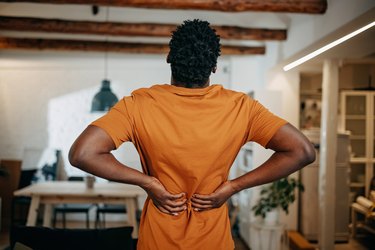
Back pain is, well, a pain. And for some people, it can even be debilitating.
This type of pain is common, too, affecting 80 percent of people at some point in their lives, per the U.S. National Library of Medicine. According to the Mayo Clinic, certain factors can increase your risk of developing back discomfort, including:
Video of the Day
Video of the Day
- Age
- Lack of exercise
- Excess weight
- Mental health disorders like anxiety and depression
- Injury
And it doesn't take a significant injury to trigger a backache: "Back pain can be caused by traumatic events like a car accident, a fall, a sports-related injury or it can happen over time due to things like work, posture or a sedentary lifestyle," says Dallas Reynolds, PT, DPT, physical therapist and director of operations support for ATI Physical Therapy.
Fortunately, there are small things you can do every day to find back pain relief. Here, experts guide you through a weeks' worth of habits that may steer you toward better back health.
Can You Really Reduce Back Pain in a Week?
OK, so you may not be completely free of back pain in a week. But every day you can do one thing that may help ease your pain over time.
"It takes time to completely eliminate back pain. But with small steps, you can start to see improvements immediately," Reynolds says. "Becoming educated on how to sit, stand, lift and sleep properly can provide immediate improvements to your spine health."
Day 1: Get More Rest
Day one is all about rest, because sleep is essential to how your mind and body function.
"Make sure you are getting the appropriate amount of sleep," Reynolds says. "Lack of sleep contributes to increased pain levels."
Indeed, inadequate sleep is linked to increased pain, especially chronic pain, according to a December 2013 review in the Journal of Pain. This may be because not getting enough rest affects your body's ability to regulate pain.
And this isn't just the case if you pull an all-nighter — even partial sleep deprivation may make you more sensitive to pain, per the study.
That's why the first step to curbing your discomfort is to assess your sleep habits and explore ways to not just sleep more, but better.
Per the Mayo Clinic, some strategies to help you get better rest include:
- Aim to get at least seven hours of sleep a night.
- Maintain a consistent sleep schedule by waking up and going to bed at the same times.
- Avoid caffeine, nicotine and alcohol before bed.
- Optimize your bedroom for sleep by making sure it's dark, quiet and at a cool temperature.
- Limit daytime naps to no more than 30 minutes to avoid disrupting nighttime rest.
Day 2: Manage Your Stress
Stress takes a toll on your health. Per the Mayo Clinic, it can cause physical symptoms like:
- Headaches
- Muscle tension or pain (including pain in your back)
- Fatigue
- Feeling overwhelmed
- Sleep problems
Stress can also make existing aches worse because, as Reynolds says, "higher amounts of stress will increase pain levels."
Stress may also trigger back pain, per the UT Southwestern Medical Center. That's because stress can increase the release of stress hormones, which can cause tension in the muscles around your spine and lead to back discomfort.
Fortunately, addressing your stress may help alleviate back aches. Per the Mayo Clinic, stress-relief strategies include:
- Exercising and stretching more
- Eating nutritious foods
- Practicing mindfulness or meditation techniques
- Scheduling time to do things that help you relax
Tip
Want to start meditating but aren't sure where to start? Try LIVESTRONG.com's beginner meditation guide.
Day 3: Take a Walk
Sometimes the solution to reducing posterior pain may be as straightforward as taking a walk.
"Walking is one of the most simple yet important things you can do to improve your back pain," Stephen Lawrence, MD, anesthesiologist and pain medicine specialist at Phelps Hospital, Northwell Health, tells LIVESTRONG.com.
Not only should you be walking more, but you should also be mindful of your posture when you stroll.
"While walking, focus on keeping your posture upright and swinging the arms gently about the shoulders," Dr. Lawrence says. "Increasing the speed at which you walk can help increase blood flow to the muscles that support the spine, as well as the spine itself. "
Tip
As an added bonus, Dr. Lawrence says that spending more time outdoors can support a better mood, which may help inspire you to commit to walking more as you work toward a pain-free back.
Day 4: Bend at Your Hips
Making small changes to how you move your body may also help support better back health.
"Our spine is meant to provide stability and support our structure, " Dr. Lawrence says. "When most people bend forward or bend down to pick something up, they bend at their spine, not their hips."
Dr. Lawrence says that when we bend at the spine instead of our hips, it places unnecessary strain on our back that can cause pain.
The fix: Practice bending at your hips throughout the day.
"Every time you put on your shoes, pick something up off the floor or lean forward when brushing your teeth, you are bending forward," Dr. Lawrence says. "If you learn to do this correctly, you will preserve the integrity of your spine and decrease your pain substantially."
Related Reading
Day 5: Move More
When you have back pain, it can be tempting to reduce physical activity. But this can actually make it worse.
"The most important thing is to never stop moving," Dr. Lawrence says. "Too often I see individuals who have injured their backs and are fearful to return to activity."
That's because exercising can help strengthen your back, which may prevent or alleviate pain.
"Doing appropriate strengthening, stretching and aerobic exercises two to three times a week has been associated with a lower risk of developing back pain, lower severity of pain and less disability associated with back pain," says Yili Huang, DO, licensed and board-certified pain management anesthesiologist and director of the Pain Management Center at Phelps Hospital, Northwell Health.
Stretches and Exercises to Help Reduce Back Pain
Per the Mayo Clinic, here are some moves that may help to alleviate back pain:
- Knee-to-chest stretch
- Lower back rotational stretch
- Bridge exercise
- Shoulder blade squeeze
- Child's pose
- Plank pose
- Assisted leg raise
Day 6: Pay Attention to Your Pain
Noticing when your back hurts can go a long way in uncovering the cause of your pain. Does it feel particularly stiff when you sit at your desk for hours? Or when you constantly bend and lift heavy items?
Think about all that you do on a daily basis to see if there are specific activities that aggravate your posterior.
"We need to assess our current job or activities that may have contributed to the back pain starting in the first place," Reynolds says. "A physical therapist can also help in the evaluation process to look at things in your life that may have contributed to the start of the back pain and help make recommendations."
Day 7: Talk to Your Doctor
Finally, talking to your doctor can also help you pinpoint the source of your pain. And if your doctor doesn't validate you or isn't able to determine a cause, it's OK to get a second (or third) opinion.
"There is always a cause of your back pain," Dr. Lawrence says. "A careful examination of your history, symptoms and other associated findings will often reveal the cause. This is important because once you understand the cause of your pain, you can begin to treat it appropriately."
- Mayo Clinic: "Back pain"
- Journal of Pain: "The association of sleep and pain: An update and a path forward"
- UT Southwestern Medical Center: "Easy tips to relieve stress-related neck and back pain"
- Mayo Clinic: "Stress symptoms: Effects on your body and behavior"
- U.S. National Library of Medicine: "Back pain"
- Mayo Clinic: "Back exercises"
- Mayo Clinic: "Stress relievers: Tips to tame stress"
- Mayo Clinic: "Sleep tips: 6 steps to better sleep"
Is this an emergency? If you are experiencing serious medical symptoms, please see the National Library of Medicine’s list of signs you need emergency medical attention or call 911.





